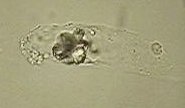|
Microorganism inclusion casts
Bacteria
 The presence of
microorganism within a cast is naturally specific to infection of
the kidney. Lindner has shown that the presence of bacteria
within a cast was pathognomonic of pyelonephritis. These casts
are described as a hyaline matrix with bacterial inclusions. As
expected, white blood cell inclusions are also present. The
detection of the bacillus is quite difficult in bright field
microscopy. The cocci will probably be interpreted as granules in
a routine specimen. Phase contrast or interference microscopy
makes the detection much easier.
The presence of
microorganism within a cast is naturally specific to infection of
the kidney. Lindner has shown that the presence of bacteria
within a cast was pathognomonic of pyelonephritis. These casts
are described as a hyaline matrix with bacterial inclusions. As
expected, white blood cell inclusions are also present. The
detection of the bacillus is quite difficult in bright field
microscopy. The cocci will probably be interpreted as granules in
a routine specimen. Phase contrast or interference microscopy
makes the detection much easier.
Yeast
Schumann, using the PAP staining procedure, has demonstrated the importance of the identification of the yeast casts. These casts are usually found in specimens of immunosuppressed patient. Yeast casts are also a very important finding in the diabetic patients. With immunosuppressed patients the route of introduction is usually the blood. Reflux with a yeast infected urine is also a possible route of entry, specially with the diabetic patient. The "Candida" casts are described, by Schumann, as casts with a rather waxy matrix with yeast inclusions. As for bacteria casts, cell inclusions, specially white blood cells, are expected.
Crystal casts
Crystal casts are defined as a hyaline matrix casts with inclusions of crystals. The presence of these casts indicates an intratubular crystallization. This crystallization can provoke renal damages. These damages can be created by an inflammation process or by obstruction. The sediment with crystal casts will usualy show other figures like renal tubular cells and other casts.
Bilirubine casts
Cases of bilirubine crystals embedded in a hyaline matrix have been reported in some cases of high bilirubinuria.
Other casts
This section is dedicated to special rare casts.
Fibrin thread casts
These casts are hyaline casts embedding, within their matrix, fibrin threads. These threads originate from the passage in the urinary space, of the coagulation proteins (fibrinogen and others). Once in urine, the fibrinogen coagulates and forms fibrin threads. These casts are strongly indicative of glomerulonephritis.
Myeloma casts
 The typical myeloma casts
are described as rather waxy matrix casts coated with macrophages
and tubular cells. These casts are thought to originate from the
precipitation of light chains at their acid isoelectric point
(4,5- 5,0). Some think that these are not true casts but an
inflammatory response to a light chain precipitate. It is not
sure that these casts are specific to myeloma.
The typical myeloma casts
are described as rather waxy matrix casts coated with macrophages
and tubular cells. These casts are thought to originate from the
precipitation of light chains at their acid isoelectric point
(4,5- 5,0). Some think that these are not true casts but an
inflammatory response to a light chain precipitate. It is not
sure that these casts are specific to myeloma.
Unknown casts
 Does someone have any
idea about this cast? Casts like this one were observed a few
times in patients with acute renal failure. Cellular casts, waxy
casts, and many tubular cells were also found in all the cases.
Does someone have any
idea about this cast? Casts like this one were observed a few
times in patients with acute renal failure. Cellular casts, waxy
casts, and many tubular cells were also found in all the cases.
A description of a similar cast called "Bubble cast" by N. IMAI is given on his site at http://square.umin.ac.jp/uri_sedi/EBUBBLECAST2.html

